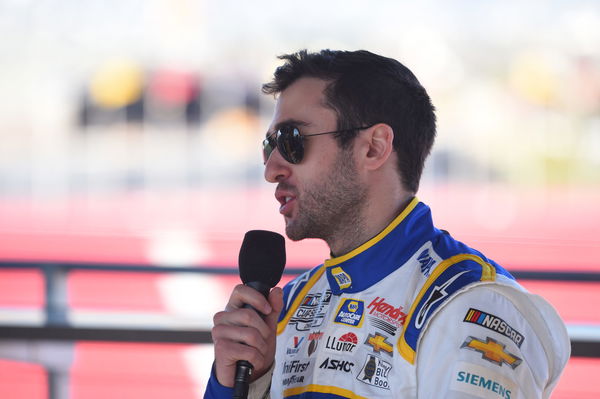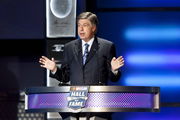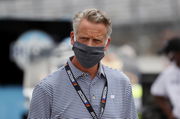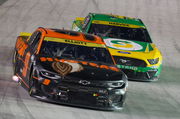
via Getty
LOS ANGELES, CA – FEBRUARY 05: Chase Elliott (#9 Hendrick Motorsports NAPA Auto Parts Chevrolet) addresses the media in a press conference during the Busch Light Clash at The Coliseum NASCAR Cup Series race on February 05, 2022, at the Los Angeles Memorial Coliseum in Los Angeles, CA. (Photo by Chris Williams/Icon Sportswire via Getty Images)

via Getty
LOS ANGELES, CA – FEBRUARY 05: Chase Elliott (#9 Hendrick Motorsports NAPA Auto Parts Chevrolet) addresses the media in a press conference during the Busch Light Clash at The Coliseum NASCAR Cup Series race on February 05, 2022, at the Los Angeles Memorial Coliseum in Los Angeles, CA. (Photo by Chris Williams/Icon Sportswire via Getty Images)
In the annals of racing history, the 2023 season will undoubtedly bear the mark of Chase Elliott’s turbulent journey, a startling twist given his promising start. Yet, every coin has two sides. Although Elliott may not be vying for the Cup in the playoffs, he’s making waves in the team-owner race. A victory at Phoenix could be the salve for the sting of his premature exit from playoff contention.
And NASCAR fans are confident about that because, even amidst the whirlwind of emotions and the weight of not making the playoff rounds, Elliott’s unwavering concentration is evident. The clarity of purpose shone through when he was asked about the quintessential skill of a racecar driver.
ADVERTISEMENT
Article continues below this ad
The pinnacle of skill a race driver should possess, as per Chase Elliott, is not what most would expect
As William Byron sped to victory in Texas, Rick Hendrick notched an unparalleled 300th team triumph—a feat none of his peers have yet achieved. Though the moment was monumental, one can’t help but muse that had it been Elliott clinching the win, the entire NASCAR community would have erupted in a grand festivity.
Yet, amidst the surrounding tumult, Chase Elliott remains laser-focused on clinching the team owner title. His resolve and ambition were palpable during an interview with theathletic.com, ahead of the pivotal Charlotte race, the curtain closer for the second round. When quizzed about the linchpin skills of a driver, his perspective was refreshingly unorthodox for someone on the NASCAR circuit.
As per theathletic.com, Elliott mused, “It’s just math, in a sense. If you give up in one area, you might gain some back in another area. When you’re going in a circle at most of these places, there is an optimum way to get around there that cuts the track up properly to make straightaways long and extract the most speed. So it’s the guys who can be the most comfortable in uncomfortable areas on track, and that changes week to week.”
Reflecting on his words, there’s a ring of truth. Every nuance of racing—be it track positioning, strategizing pit stops, or deciding on overtakes—boils down to calculations. Yet, more than offering an insightful perspective, Elliott’s response was a testament to a renewed self-assuredness that many felt had been dormant.
Elliott’s unyielding self-belief is echoed by legions of his admirers. Yet, there’s something distinctly profound when such confidence emanates from one’s own mentor. Would you agree?
Watch This Story: NASCAR Community Holds Tony Stewart Guilty as Chase Elliott Takes HMS Across the Line
ADVERTISEMENT
Article continues below this ad
Trending
Rick Hendrick gives a reality check and a reason why Elliott and Alex Bowman are out of the playoffs
In the complicated dance of motorsport, it’s all too common for the blame to ping pong between team and driver regarding performance dips and failures. However, when the tag “HMS favorite” is attached to Chase Elliott, it carries significant weight. For Rick Hendrick to step forward in defense of Elliott speaks volumes, serving as a balm to the driver’s psyche.
Hendrick remarked, “When Chase is out of the car and when Alex [Bowman] is out of the car, look at the time they lose with the others racing. Yeah, we got the information, but the car has to be tuned to the driver. They get back in the car, and they got to catch up. In this sport, you don’t catch up easily. People don’t wait for you.”
ADVERTISEMENT
Article continues below this ad
Yet, in a characteristic display of humility, Elliott neither fully endorsed nor refuted Hendrick’s viewpoint. He offered, “I really don’t think the cars are the problem. I think I need to be better…I just don’t think that’s an excuse. It’s just not how I work. I think I can be better. I think I can do more to extract the pace out of our car.” The statements raise a compelling question: Was the root of the issue Elliott’s need to push his boundaries further, or did a misalignment between driver and machine throw a wrench in the works? What are your thoughts?
ADVERTISEMENT
ADVERTISEMENT
ADVERTISEMENT
ADVERTISEMENT






